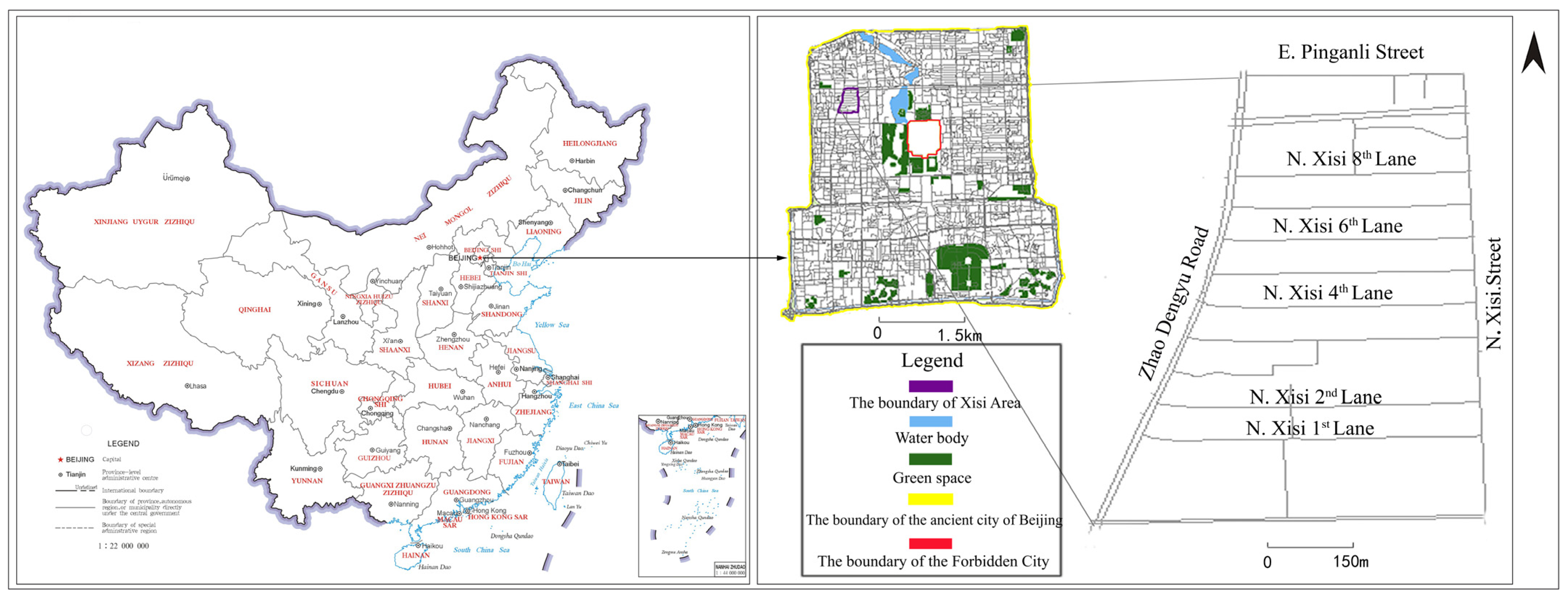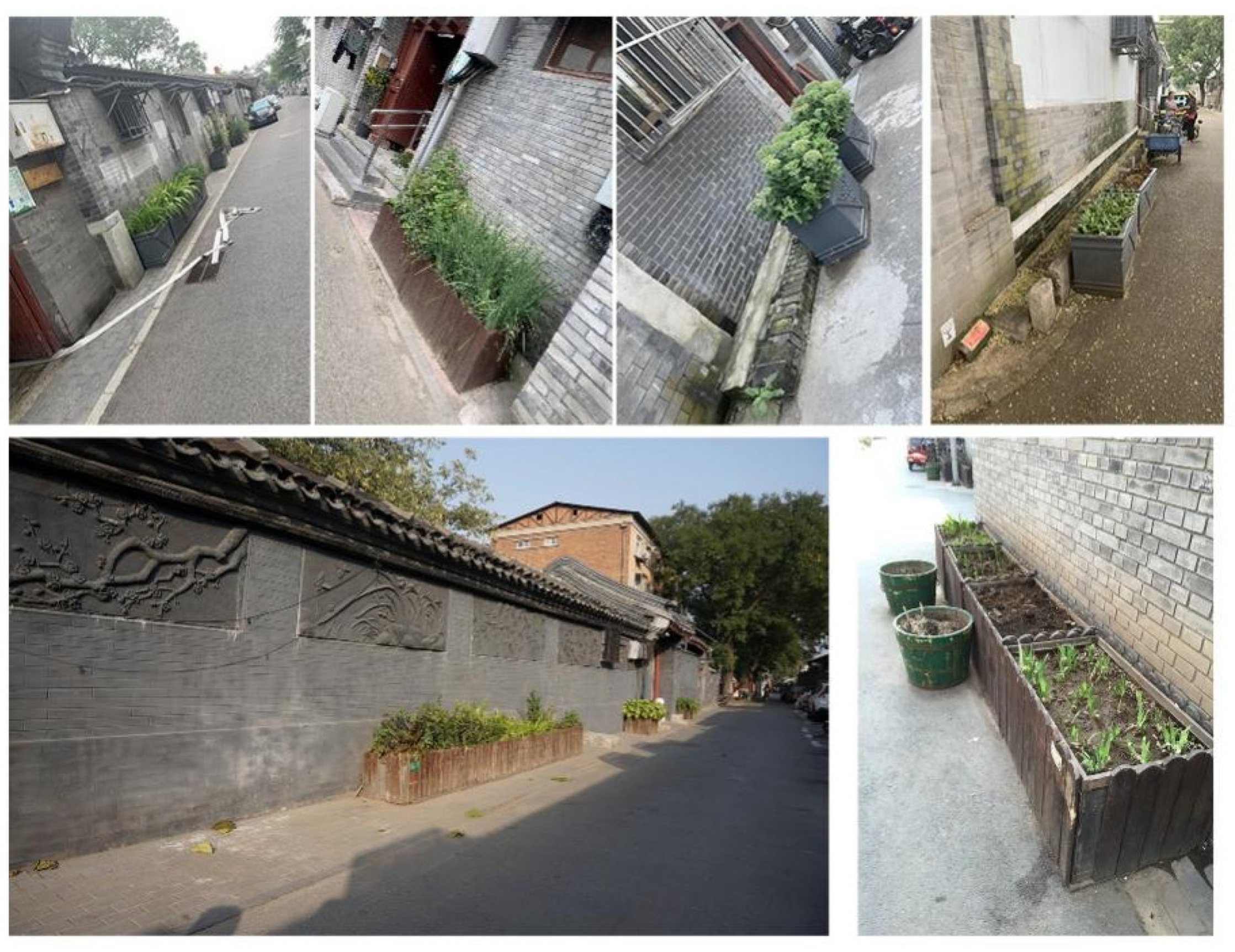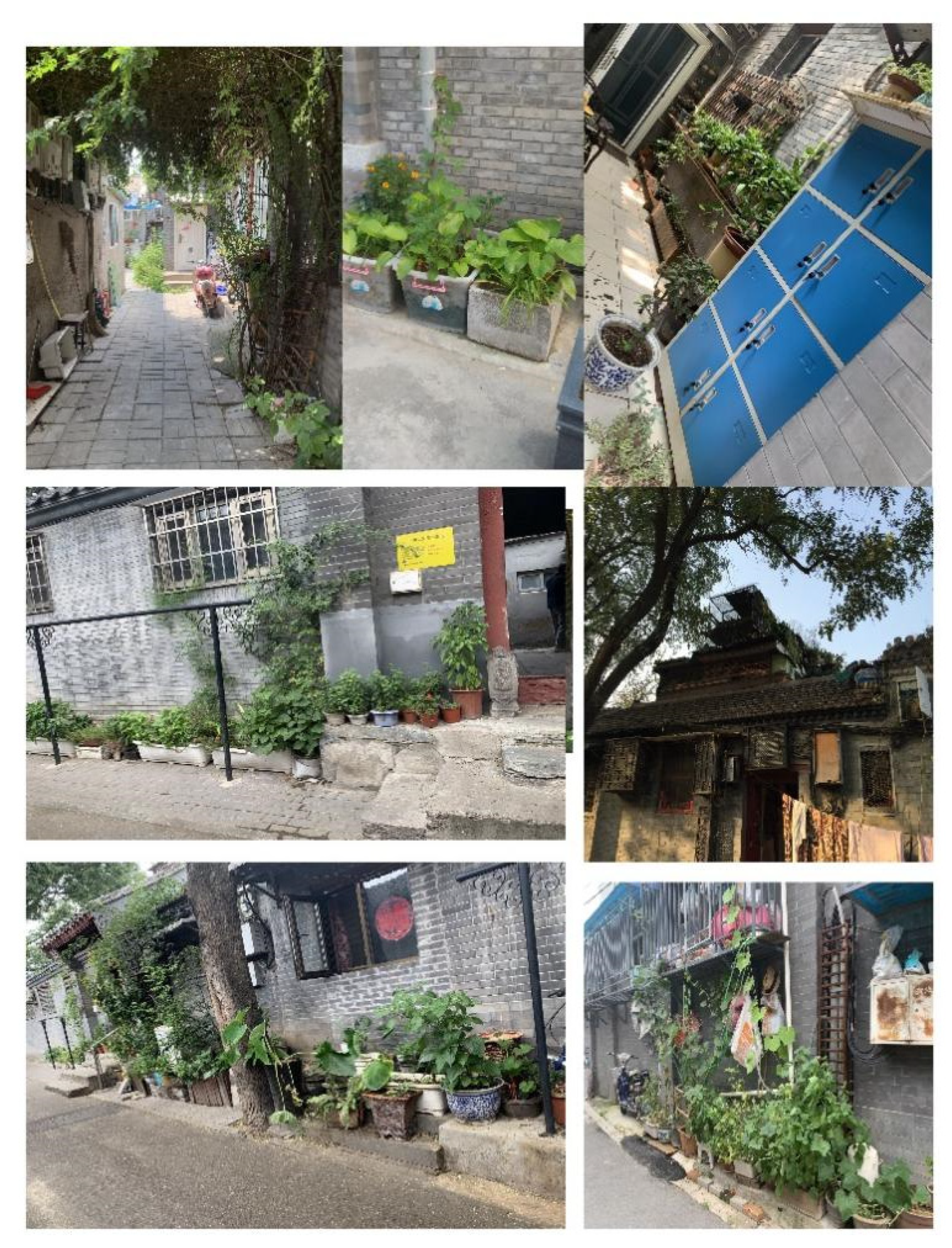Interactions among Trialectic Spaces and Their Driving Forces: A Case Study of the Xisi Historical and Cultural Block in Beijing
Abstract
:1. Introduction
2. Literature Review
2.1. About the City’s Space
2.2. The Concept of Trialectic Spaces
2.3. The Interaction among Trialectic Spaces and the Driving Forces for This Interaction
3. Case Study Area and Study Methods
3.1. Study Area
3.2. Study Methods
4. Interactions among Green Spaces’ Trialectic Spaces
4.1. Representations of Space
4.2. Spatial Practice
4.3. Residents’ Attitudes toward Representations of and Practice in Green Spaces
4.3.1. The Overall Situation
4.3.2. “Opposition” from Residents of Different Subjects
- (1)
- Long-term residents’ “Opposition”
- (2)
- Housewives’ “Opposition”
- (3)
- Retired Elderly Residents’ “Opposition”
- (4)
- Unemployed Men’s “Resistance”
4.3.3. Residents’ Representational Spaces of Plants
5. Local Administrators’ Spatial Practices
6. Residents’ Representational Spaces Originally Occupied by Flowerbeds
7. Conclusions and Discussion
7.1. Conclusions
- (1)
- Representational spaces play a decisive role in the interaction of trialectic spaces. This is consistent with Babere’s findings.
- (2)
- In historical and cultural blocks, culture is the driving force promoting the interaction of trialectic spaces.
- (3)
- The direction of interaction among trialectic spaces can be either clockwise or counterclockwise.
7.2. Discussion
Author Contributions
Funding
Institutional Review Board Statement
Informed Consent Statement
Data Availability Statement
Conflicts of Interest
References
- Lefebvre, H. The Production of Space; Nicholson-Smith, D., Translator; Blackwell: Oxford, UK, 1991; pp. 11–12, 33, 38–50, 223–224, 287–312, 362. [Google Scholar]
- Lefebvre, H. Writings on Cities; Kofman, E.; Lebas, E., Translators; Basil Blackwell: Oxford, UK, 1996. [Google Scholar]
- Lefebvre, H. Critique of Everyday Life; Verso: London, UK, 2002; Volume 2, p. 40. [Google Scholar]
- Dward, W. Soja. In Third Space; Lu, Y.; Liu, J.L., Translators; Shanghai Education Press: Shanghai, China, 2005; pp. 85–87, 95, 100. [Google Scholar]
- Gottdiener, M. Social Production of Urban Space; University of Texas: Austin, TX, USA, 1985. [Google Scholar]
- Okuyucu, Ş.E.; Çoban, G. Experiencing the corona effect in the city square through Lefebvre’s spatial trialectic: The case of Afyonkarahisar. Appl. Nanosci. 2021. Early Access. [Google Scholar] [CrossRef] [PubMed]
- Sletto, B. Producing space(s), representing landscapes: Maps and resource conflicts in Trinidad. Cult. Geogr. 2002, 9, 389–420. [Google Scholar] [CrossRef]
- Babere, N.J. Social production of space: “Lived space” of informal livelihood operators; the case of Dares Salaam City Tanzania. Curr. Urban Stud. 2015, 3, 286. [Google Scholar] [CrossRef] [Green Version]
- Hartshorne, R. The concept of geography as a science of space, from Kant and Humboldt to Hettner. Ann. Assoc. Am. Geogr. 1958, 48, 97–108. [Google Scholar] [CrossRef]
- Gregory, D.; Johnston, R.; Pratt, G.; Watts, M.; Whatmore, S. The Dictionary of Human Geography, 5th ed.; Blackwell Publishing: Hoboken, NJ, USA, 2009; pp. 707–710. [Google Scholar]
- Abler, R.J.S.; Adams, R.; Gould, P. Space Organization: The Geographer’s View of the World; Prentice-Hall: Englewood Cliffs, NJ, USA, 1971. [Google Scholar]
- Holt-Jensen, A. Geography: History and Concepts; Fullerton, B., Translator; Paul Chapman: Frome, UK, 1988. [Google Scholar]
- Hubbard, P. Thinking Geographically: Space, Theory and Contemporary Human Geography; Continuu: London, UK, 2002. [Google Scholar]
- Sayer, A. The Difference that Space Make. In Social Relations and Spatial Structures; Gregory, D., Urry, J., Eds.; Higher and Further Education Division, Macmillan Publishers LTD.: Hong Kong, China, 1985; pp. 49–66. [Google Scholar]
- Lefebvre, H. Writings on Cities, 1st ed.; Wiley-Blackwell: London, UK, 1996; p. 100. [Google Scholar]
- Paasi, A. Place and region: Looking through the prism of scale. Prog. Hum. Geogr. 2004, 28, 536–546. [Google Scholar] [CrossRef]
- Pred, A.R. The Spatial Dynamics of US Urban-Industrial Growth, 1800–1914: Interpretive and Theoretical Essays; MIT Press: Cambridge, MA, USA, 1966; pp. 5–6. [Google Scholar]
- Massey, D.; Allen, J.; Anderson, J.; Cunningham, D.; Hamnett, C.; Sarre, P. (Eds.) Geography Matters!: A Reader; Cambridge University Press: Cambridge, UK, 1984; pp. 5–11. [Google Scholar]
- Massey, D.; Massey, D.B. For Space; Sage: New York, NY, USA, 2005. [Google Scholar]
- Ley, D. A social Geography of the City; Harper and Row: New York, NY, USA, 1983. [Google Scholar]
- Thrift, N. Space: The fundamental stuff of geography. In Key Concepts in Geography; Holloway, S.L., Rice, S., Valentine, G., Eds.; Sage: London, UK, 2003; pp. 95–108. [Google Scholar]
- Rob Shields. Henri Lefebvre: Introduction [EB/OL]. Available online: http://www.slidefinder.net/h/henri_lefebvre_introduction_rob_shields/lecture/5419117 (accessed on 27 September 2015).
- Delaisse, A.C.; Huot, S.; Veronis, L. Conceptualizing the role of occupation in the production of space. J. Occup. Sci. 2020, 28, 550–560. [Google Scholar] [CrossRef]
- Halvorsen, S. Spatial dialectics and the geography of social movements: The case of Occupy London. Trans. Inst. Br. Geogr. 2017, 42, 445–457. [Google Scholar] [CrossRef] [Green Version]
- Newlands, G. Algorithmic surveillance in the gig economy: The organization of work through Lefebvrian conceived space. Organ. Stud. 2021, 42, 719–737. [Google Scholar] [CrossRef]
- Kingma, S. New ways of working (NWW): Work space and cultural change in virtualizing organizations. Cult. Organ. 2019, 25, 383–406. [Google Scholar] [CrossRef] [Green Version]
- Carp, J. “Ground-Truthing” Representations of Social Space Using Lefebvre’s Conceptual Triad. J. Plan Educ. Res. 2008, 28, 129–142. [Google Scholar] [CrossRef]
- Proctor, D. The Social Production of internet Space: Affordance, Programming, and Virtuality. Commun. Theor. 2021, 31, 593–612. [Google Scholar] [CrossRef]
- Farmaki, A.; Christou, P.; Saveriades, A. A Lefebvrian analysis of Airbnb space. Ann. Tourism Res. 2020, 80, 102806. [Google Scholar] [CrossRef]
- Tynen, S. Lived space of urban development: The everyday politics of spatial production in Nanjing, China. Space Cult. 2019, 22, 172–188. [Google Scholar] [CrossRef]
- Yu, G.; Zhong, S. Borrowed production: Spatial processes of urban waterfront tourism in Guangzhou. J. Tour. Cult. Chang. 2021, Early Access, 1–16. [Google Scholar] [CrossRef]
- Wolf, G.; Mahaffey, N. Designing difference: Coproduction of spaces of potentiality. Landsc. Urban Plan 2016, 1, 59–67. [Google Scholar] [CrossRef]
- Parkin, S.; Coomber, R. Public injecting drug use and the social production of harmful practice in high-rise tower blocks (London, UK): A Lefebvrian analysis. Health Place 2011, 17, 717–726. [Google Scholar] [CrossRef]
- Ford, D.R. A pedagogy for space: Teaching, learning, and studying in the Baltimore Rebellion. Policy Futures Educ. 2015, 14, 176–193. [Google Scholar] [CrossRef] [Green Version]
- Sun, J.X.; Zhang, S.Q.; Ji, M.J. Revisiting the impacts of tourism from the perspective of social space production: An ethnological study of the Muslim community in Sanya, Hainan Province, China. Curr. Issues Tour. 2019, 23, 1845–1863. [Google Scholar] [CrossRef]
- Cook, W.R.A. A tale of two cafes: Spatial production as de facto language policy. Curr. Issues Lang. Plan. 2021, 22, 535–552. [Google Scholar] [CrossRef]
- Mayers, R.; Glover, T. Safe cycling space: How it is produced and experienced by cyclists. J. Leisure Res. 2021, 52, 370–391. [Google Scholar] [CrossRef]
- Zhu, X.X.; Qiao, J.J. Sustainable Development of Rural Tourism Community: Based on the Analysis from the Perspective of Ternary Dialectics on Production of Space. Econ. Geogr. 2020, 40, 153–164. [Google Scholar] [CrossRef]
- Zhang, Q. Concentrated residential area of peasants—Residential form and everyday life. In Urban Development—The Political Sociology of Space Production; Cheng, Y.F., Ed.; Shanghai Ancient Books Publishing House: Shanghai, China, 2009; pp. 132–180. [Google Scholar]
- Ming, Q.C.; Duan, C. Spatial Reconstruction of Tourism Landscapes of Old Towns in the Theoretical Perspective of Spatial Production. J. Yunnan Norm. Univ. (Humanit. Soc. Sci.) 2014, 46, 42–48. [Google Scholar]
- Cheng, Z.; Zhou, S.; Zhang, B. The Spatial Factors of Cultural Identity: A Case Study of the Courtyards in a Historical Residential Area in Beijing. Sustainability 2018, 10, 2587. [Google Scholar] [CrossRef] [Green Version]
- Chen, X.Y.; Zhu, X.D.; Lian, Y.R. Renovation and protection planning of Xisi Historical and cultural conservation areas in Beijing. In Proceedings of the 2006 Annual Conference of Human Settlements Specialty of Architect Branch of Architectural Society of China, Xinjiang, China, October 2006. [Google Scholar]
- People’s Government of Beijing Municipality. Beijing old City historical and cultural conservation area protection and control scope planning. In A New Practical Manual for Cultural Heritage Work; Beijing Municipal Bureau of Cultural Heritage: Beijing, China; Economic Management Publishing House: Beijing, China, 2012; p. 540. [Google Scholar]
- Beijing Planning Commission. Protection Plan of 25 Historical and Cultural Conservation Areas in Beijing Old CITY; Beijing Yanshan Press: Beijing, China, 2002; pp. 10–15. [Google Scholar]
- Beijing Municipal Bureau of Cultural Heritage. A New Practical Manual for Cultural Heritage Work; Economic Management Publishing House: Beijing, China, 2012; pp. 513–548. [Google Scholar]
- Guillaume, X. Resistance and the international: The challenge of the everyday. Int. Polit. Sociol. 2011, 5, 459–462. [Google Scholar] [CrossRef]
- Yılmaz, G.G. The Voice of Invisible Pluralities In Everyday Life; Resistance In Everyday Life And German Turks As A Case Study. Int. J. Arts Sci. 2014, 7, 41. [Google Scholar]
- Lilja, M.; Vinthagen, S. Dispersed resistance: Unpacking the spectrum and properties of glaring and everyday resistance. J. Political Power 2018, 11, 211–229. [Google Scholar] [CrossRef]
- Lian, Y.C. Escape However Do Not Leave: Michele de Certeau’s Resistance Theory. Hebei Acad. J. 2004, 24, 80–84. [Google Scholar]
- Deng, D.R.; Lian, Z.X. The Value of News; Economic Daily Press: Beijing, China, 2003; p. 237. [Google Scholar]
- de Certeau, M. The Practice of Everyday Life; University of California Press: Berkeley, CA, USA, 1988; p. 18. [Google Scholar]
- de Certeau, M. The Practice of Everyday Life: Living and Cooking (Volume 2); U of Minnesota Press: Minneapolis, MN, USA, 1998; pp. 100–150. [Google Scholar]
- Seamon, D. Body-subject, Time-space Routines, and Place-ballets. In The Human Experience of Space and Place; Buttimer, A., Seamon, D., Eds.; Croom Helm: London, UK, 1980; pp. 148–159. [Google Scholar]
- McCann, E.J. Race, protest, and public space: Contextualizing Lefebvre in the US city Antipode. Antipode 1999, 31, 163–184. [Google Scholar] [CrossRef]





| No. | Age | Living Address | No. | Age | Living Address |
|---|---|---|---|---|---|
| F1 | 45 | The sixth lane in the northern area of Xisi | M4 | 61 | The third lane in the northern area of Xisi |
| M1 | 73 | The fifth lane in the northern area of Xisi | M5 | 63 | The third lane in the northern area of Xisi |
| M2 | 67 | The eighth lane in the northern area of Xisi | F5 | 82 | The second lane in the northern area of Xisi |
| F2 | 70 | The fifth lane in the northern area of Xisi | F6 | 50 | The sixth lane in the northern area of Xisi |
| F3 | 64 | The fifth lane in the northern area of Xisi | M7 | 73 | The third lane in the northern area of Xisi |
| M3 | 61 | The fourth lane in the northern area of Xisi | M6 | 70 | The fifth lane in the northern area of Xisi |
| F4 | 61 | The third lane in the northern area of Xisi |
Publisher’s Note: MDPI stays neutral with regard to jurisdictional claims in published maps and institutional affiliations. |
© 2022 by the authors. Licensee MDPI, Basel, Switzerland. This article is an open access article distributed under the terms and conditions of the Creative Commons Attribution (CC BY) license (https://creativecommons.org/licenses/by/4.0/).
Share and Cite
Cheng, Z.; Fan, B.; Zhou, S.; Zhang, B. Interactions among Trialectic Spaces and Their Driving Forces: A Case Study of the Xisi Historical and Cultural Block in Beijing. Sustainability 2022, 14, 5094. https://doi.org/10.3390/su14095094
Cheng Z, Fan B, Zhou S, Zhang B. Interactions among Trialectic Spaces and Their Driving Forces: A Case Study of the Xisi Historical and Cultural Block in Beijing. Sustainability. 2022; 14(9):5094. https://doi.org/10.3390/su14095094
Chicago/Turabian StyleCheng, Zhifen, Boning Fan, Shangyi Zhou, and Baoxiu Zhang. 2022. "Interactions among Trialectic Spaces and Their Driving Forces: A Case Study of the Xisi Historical and Cultural Block in Beijing" Sustainability 14, no. 9: 5094. https://doi.org/10.3390/su14095094
APA StyleCheng, Z., Fan, B., Zhou, S., & Zhang, B. (2022). Interactions among Trialectic Spaces and Their Driving Forces: A Case Study of the Xisi Historical and Cultural Block in Beijing. Sustainability, 14(9), 5094. https://doi.org/10.3390/su14095094





